Which Lot Tracking Software Solutions Are Best for Food Distributors?
If you’re a food distributor looking for lot tracking software to beef up your lot tracking capabilities, you’re probably sick of reading discussion threads and forums intended for manufacturers.
This can be frustrating, given that distributors—particularly those working in the food and beverage industry—deal with complex traceability standards imposed by suppliers, retailers and federal regulations.
What’s more, our research shows that consumers hold distributors responsible for ensuring food safety and effectively managing recalls. And “green” consumers are demanding fresher food as well as more information about the origins of the food they purchase. So how can you satisfy the demands of consumers, manufacturers and retailers alike?
This article analyzes the different types of lot tracking systems that are suitable for distributors.
We spoke with experts and surveyed consumers on their attitudes toward food-chain traceability to help you understand what functionality your distribution business needs.
Here’s what we’ll cover:
Software Types Offering Lot Tracking
Key Indicators That Your Distribution Business Needs Better Lot Tracking
Consumer Trends Fueling Push Toward Better Lot Tracking
Consumers Hold Distributors Responsible in Recalls
What Is Lot Tracking?
Lot tracking, also known as “lot control,” simply refers to recording a product’s lot number (generally, using software) in order to track it through a supply chain process, such as warehouse receiving. In certain cases, such as warehouse order picking, the product’s lot number can also be used to direct supply chain processes.
Finally, the lot number can be used for accounting and inventory reporting purposes.
Not all kinds of supply chain management systems allow the same level of control over lot numbers. Some only allow for the bare minimum to maintain regulatory compliance: that is, basic recording of the lot numbers of products you receive into, or ship out of, inventory.
With a traceability-focused ERP system or dedicated traceability software, on the other hand, the product’s lot number follows it from production all the way to the retailer’s shelf. This allows for easy identification of the original supplier in case of a recall.
Software Types That Offer Lot Tracking
Let’s take a quick look at the kinds of software products with lot tracking capabilities. Each offers a different level of control over lot numbers:
Distribution accounting software can utilize lot control for determining landed costs per lot.
Inventory management software can track inventory movements using lot numbers; e.g., orders received and orders shipped.
Warehouse management systems (WMSs) can track receiving and shipping processes using lot numbers, like inventory management software can—but with WMS software, lot numbers can also be utilized in warehouse slotting and order picking.
Manufacturing resource planning (MRP) software allows for the use of lot numbers in planning production runs.
Manufacturing execution software (MES) can provide lot control over the ingredients that go into a finished product.
Even in ERP systems, MRP and MES modules are frequently where a product’s traceability journey begins. However, full lot traceability involves pervasive lot control features throughout the integrated modules that make up an ERP system.
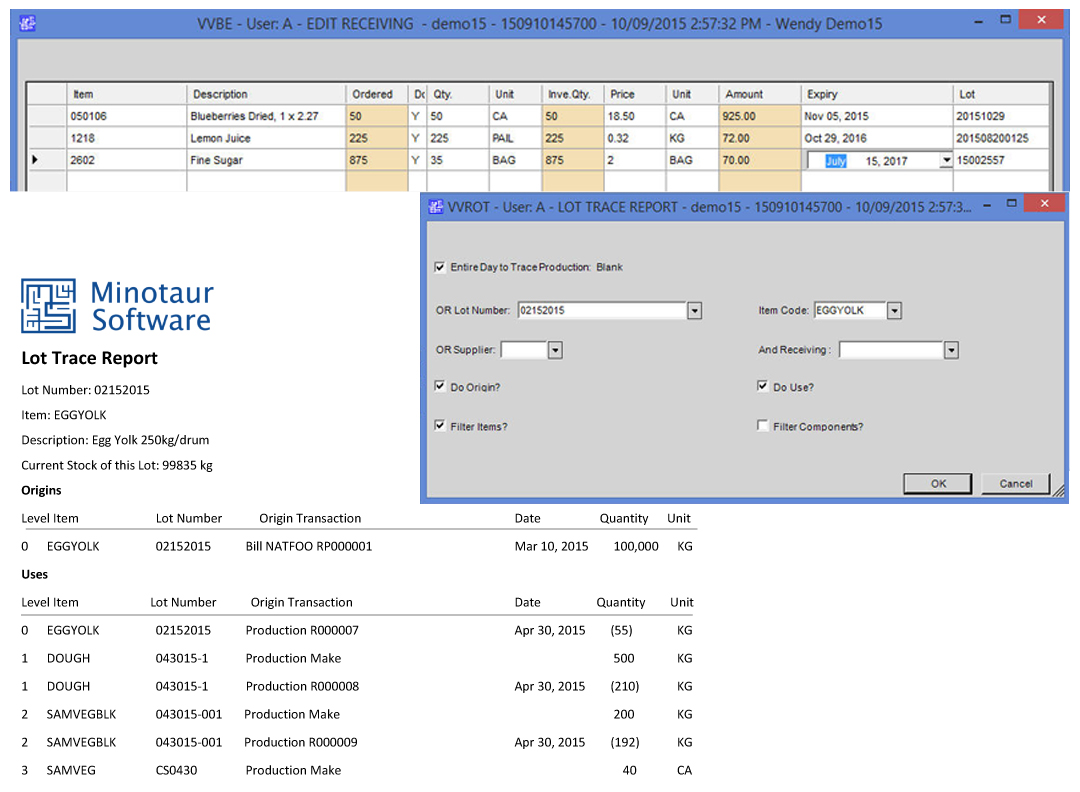
_Lot control features for ingredient-level traceability in manufacturing module of
Minotaur Software’s ERP system_
Alternatively, dedicated software can be integrated with a pre-existing ERP system to enable comprehensive lot control functionality throughout the ERP system’s modules.
Key Indicators That Your Business Needs Better Lot Tracking
What, then, are some of the situations in which a traceability-focused ERP system is necessary for distributors, as opposed to a stand-alone system with more limited lot tracking features?
In order to answer this question, we spoke with Judith Kirkness, author of The Traceability Factor and principal consultant at Minotaur Software, an ERP developer focusing on traceability technologies.
Kirkness explains that “traceability systems today are designed for internal traceability—meaning that they provide one-up, one-down traceability for whichever company is using that system.” In other words, many traceability systems only ensure that products can be tracked one link forward or backward in the supply chain, as this limited form of traceability is often enough for regulatory compliance.
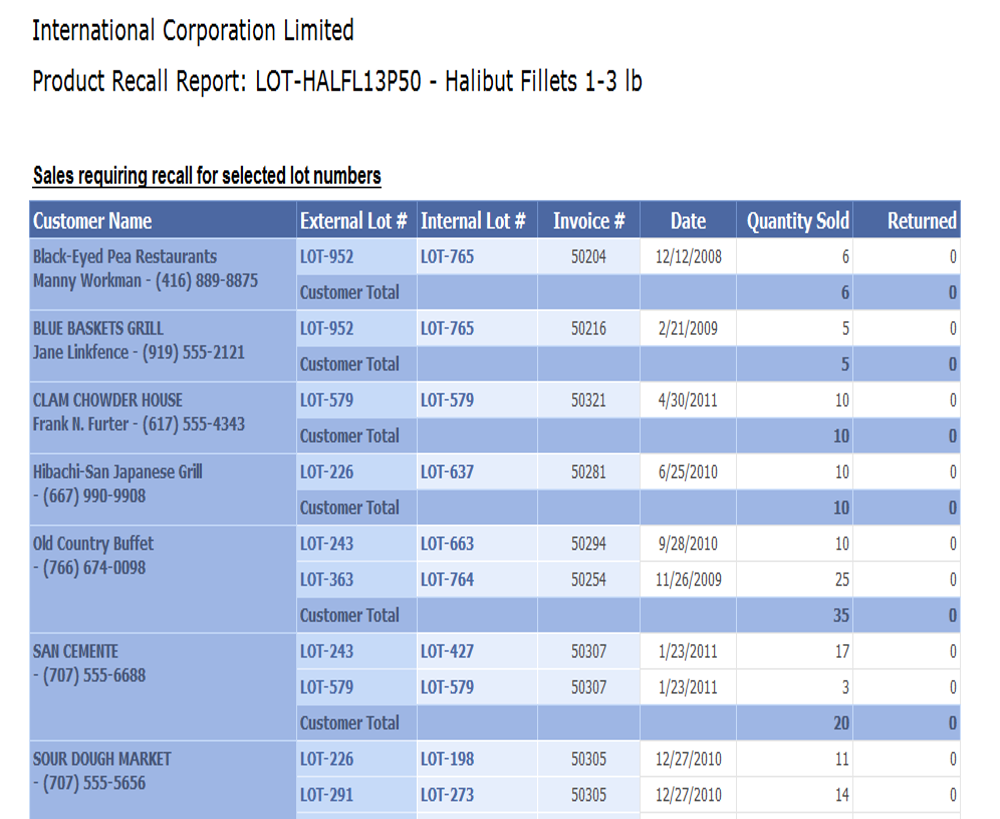
Tracking lot numbers of sold products for recall management in Blue Link’s ERP system
That said, Kirkness notes that “the Global Food Traceability Center (which is part of the IFT) is working on standards, starting with the higher-risk food sectors (e.g., produce and seafood), that will enable supply chain traceability across disconnected suppliers to become a reality.”
As these standards gain traction, the pressure on distributors to implement better lot tracking will become greater than ever.
Since distributors aren’t generally involved in production, lot tracking features in the stand-alone applications we’ve reviewed are enough to maintain compliance in many contexts.
The distributor merely needs to record and preserve the manufacturer’s lot number, so bad products can be identified after they hit retailers’ shelves. However, some distributors have needs that require the use of a specialized or integrated ERP system.
One case of this is quite straightforward: size.
“Companies with a small amount of products and small customer and supplier lists may be able to lot-track products through manual methods or by using stand-alone software,” says Jordan Rotman, product expert at Blue Link (a developer of ERP solutions for the distribution industry).
However, he notes, growing companies will quickly outgrow manual and stand-alone methods.
“It is at this point that an ERP system with strong lot traceability features becomes necessary. A proper ERP system creates cost-saving opportunities for businesses, by reducing labor costs and the costs associated with manually managing a recall,” he adds.
Other considerations behind the decision to implement a traceability-focused ERP system have more to do with how your company does business than with the size of the business itself. Kirkness explains that distributors can benefit from improved lot tracking in the following scenarios:
Business Models That Benefit From Better Lot Tracking
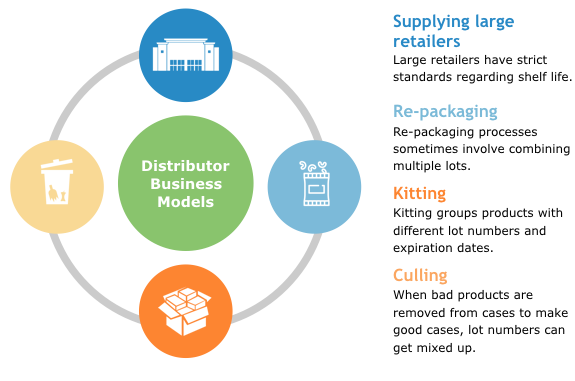
Let’s take a look at each of these scenarios in detail:
 Supplying Large Retailers
Supplying Large Retailers
Kirkness observes that retailer standards governing suppliers are sometimes stricter than federal regulations governing suppliers, particularly for larger retailers such as Costco and Wal-Mart.
As Kirkness describes, common warehouse picking methods often fall short when distributors must ship products to multiple retailers with complex rules governing shelf life. One such method is FIFO (first in, first out), in which the products that were received first are picked for customers first. FEFO (first expired, first out) is a similar, but more sophisticated, method in which products that will expire first are picked first.
“Say you sell to Wal-Mart. Wal-Mart has a 75 percent shelf-life rule for suppliers of certain products. Some of your customers might accept the oldest products, but Wal-Mart may not, depending on the expiration dates. … For food, FIFO is just not good enough,” she says.
Such situations necessitate better control over lot numbers, Kirkness notes; otherwise, distributors can face fines from their supply chain partners for failing to adhere to standards.
Indeed, Rotman says that “many big-box retail businesses will only deal with distributors with ERP systems and traceability functionality in place.”
Traceability ERP systems can also be necessary for distributors that handle e-commerce sales, Rotman adds, “as these sales are often being made to the end consumer.” Knowing which e-commerce customers received which lots would thus be necessary in order to ensure one-up, one-down traceability.

 Re-packaging and Kitting
Re-packaging and Kitting
Re-packaging and kitting are related value-added services that distributors perform for manufacturers. Kirkness gives an example of why these services pose special lot-tracking challenges.
“Some jam company might make a deal with a retailer to provide point-of-purchase cardboard displays that combine a variety of their products—e.g., strawberry, blueberry and peach jam,” she says. “If the distributor, as opposed to the manufacturer, is doing the repackaging, the chances that those products were produced on the same day and that they have the same lot number are very small.
“You’re combining a bunch of products with different lot numbers and making a new product from it. Now, the manufacturer can no longer tell which retailer got which lot numbers, assuming they ship to multiple retailers from your facility,” Kirkness explains.
For the manufacturer to maintain lot traceability in this scenario, the distributor must have better control over lot numbers in order to report back to the manufacturer which lot numbers went into which kits. Simpler forms of expiration date tracking may not be enough for managing kits.
“Picture a multi-pack of three different flavors,” Kirkness says. “Is the expiration date of the package the earliest expiration date of one of the products it contains?” In this scenario, tracking the lot numbers of products within the kit allows for better control over the product’s shelf life.
 Culling
Culling
This simply refers to identifying and removing bad products, which is a common practice in fresh food distribution.
Kirkness explains that a fresh produce distributor “might have 20 cases on a skid, but some of them are going bad, so they’ll make 15 good cases from 20 original ones. The cases may have all been from the same lot, but they may not have been.”
If you end up culling products heavily in your warehouse before shipping them out, improved lot tracking will allow you to manage the shelf life of products consisting of mixed lots (since expiration dates can remain associated with the numbers of lots that have been blended in the good case).
What’s more, a traceability system will allow you to manage recalls involving culled products, whereas more basic lot tracking features wouldn’t be enough in a fresh-food recall.
Consumer Trends Fueling Push Toward Better Lot Tracking
We’ve seen that the major pressures on distributors to implement better lot tracking are currently from manufacturers and retailers. However, pressure is beginning to emerge from another group: consumers.
As more and more consumers adopt “green” (sustainable) or “healthy” eating habits, questions about the origins and handling of food products have become increasingly common.
Rotman notes that this trend has begun to push manufacturers and distributors to adopt better tracking functionality: “In the past, the demand for lot traceability was largely related to recalls; however, more and more, … where a product was produced and the conditions under which it was produced are factoring into consumer buying trends.”
We randomly surveyed consumers in the U.S. to ask about their attitudes toward food-chain traceability, and found that most consumers identify as either “health-conscious,” “green” or both:
Consumers’ Self-Identified Food-Buying Habits
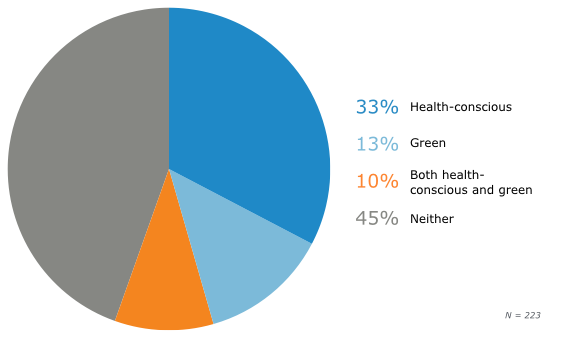
Our survey also shows that green and health-conscious consumers have different priorities when it comes to food-chain traceability. For example, take the chart below, which compares the reasons why our overall sample believes lot tracking is important with the reasons given by green consumers:
Consumers’ Top Reasons for Valuing Lot Tracking Software
![]()
Interestingly, green consumers place a much greater emphasis on the freshness of food than do members of our overall sample. They also prioritize ecological protection to a greater extent.
Surprisingly, however, none of the green consumers in our sample think that using lot tracking to ensure compliance with organic standards is the major reason to implement the technology.
This suggests that organic sourcing may need to take a backseat to fresh, sustainable sourcing in certain traceable supply chains.
The concern for food safety that the above chart shows is significant. Across the board, few of our respondents are willing to purchase a food product for which ingredients can’t be tracked in case of a recall:
Consumer Willingness to Buy Food Without
Ingredient-Level Lot Tracking
![]()
We can see that consumers are quite anxious about ingredient-level lot tracking in recall scenarios. Only 16 percent of our sample is willing to buy a product if the ingredients it contains can’t be traced.
Lot tracking can help identify which ingredients went into a food product in case of a recall, as manufacturers can associate lot numbers with ingredients. Close tracking of the manufacturer’s lot numbers can therefore help distributors ensure rapid damage control in a recall scenario—which means retaining lot numbers through processes such as culling and kitting.
Consumers Hold Distributors Responsible in Recalls
While manufacturers are the most likely targets of blame in a recall, this doesn’t mean that consumers let distributors or logistics providers off the hook:
Party Consumers Hold Responsible for Recalls
in Food Supply Chains
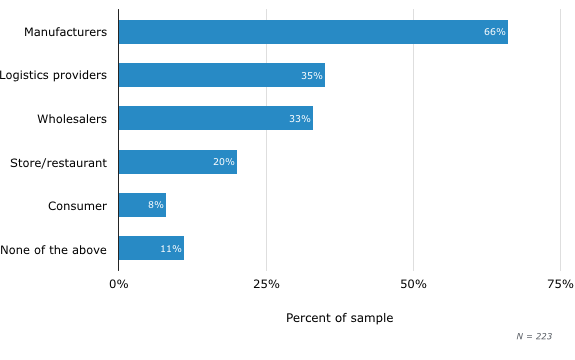
Unsurprisingly, the majority of consumers hold manufacturers responsible—but more than one-third also attribute responsibility to “companies involved in shipping the product” (shortened to “logistics providers” in the chart). Nearly as many hold wholesalers responsible, while far fewer believe that the store or restaurant where the item was purchased is to blame.
Of course, the damage done to distributors in a recall scenario is mainly due to negative perceptions of the brands they distribute. This is the primary reason manufacturers and distributors need to work closely to ensure fast, effective recall management.
It also means that distributors with the needs we’ve reviewed (e.g., strict shelf-life standards to follow, kitting, culling) will need to begin implementing traceability-focused ERP systems or dedicated traceability software.
Now that we’ve reviewed the major lot tracking solutions that are currently available, you can download our guide to food distribution software types and pricing structures to create of shortlist of vendors that meet your needs.
This guide discusses the various kinds of traceability systems used by distributors and compares pricing structures for different system types.
If you have comments or would like to obtain access to any of the charts above, please contact danielharris@softwareadvice.com.